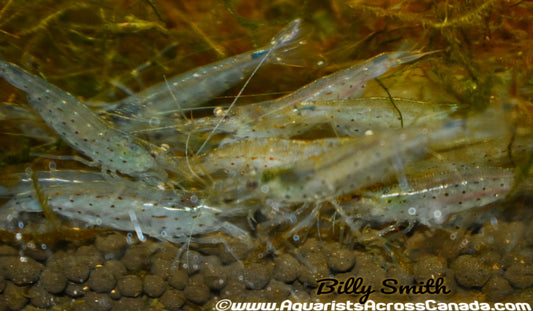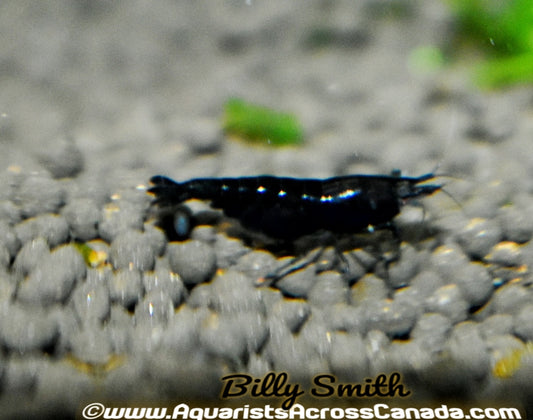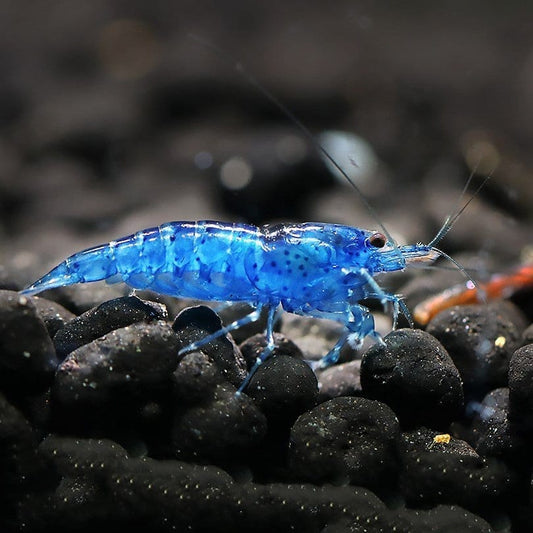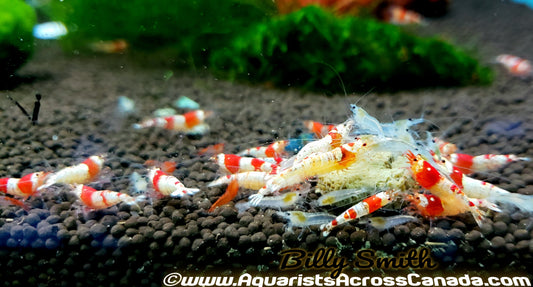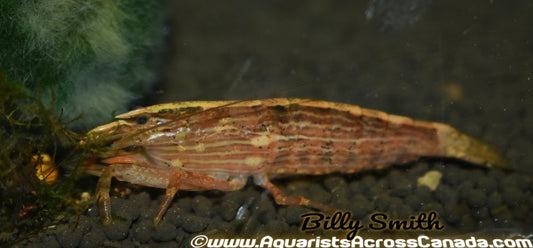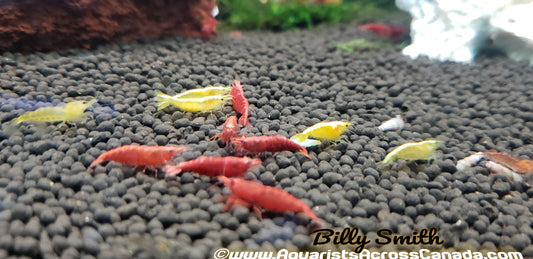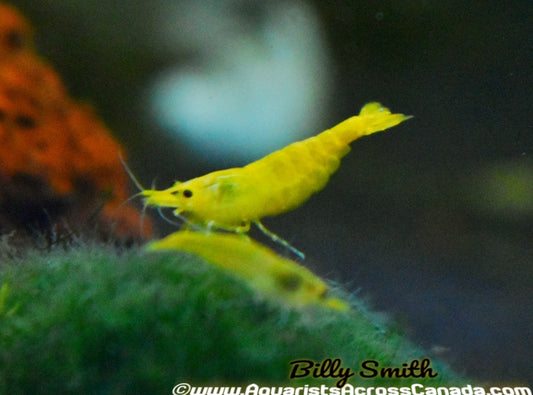Collection: Shrimp
Dwarf freshwater shrimp have become increasingly popular as algae eaters, general scavengers and for many aquarists, interesting additions to desktop “nano” aquariums and natural planted biotopes. From the basic ghost shrimp (Palaemonetes paludosus), typically sold as feeder shrimp, to the well-known Amano or algae-eating shrimp (Caridinia multidentata), to the popular red cherry shrimp (Neocaridinia heteropoda), to crystal and bee shrimp (Caridinia cantonensis), to the filter-feeding bamboo shrimp (Atyopsis moluccensis), the list of shrimp for aquarists to consider continues to grow. Regardless of one’s budget or experience level, dwarf freshwater shrimp offer something unique and truly different for aquarists with small to medium-sized aquariums.
Most dwarf freshwater shrimp kept by aquarists have their origins in eastern Asia, with the exception of ghost shrimp which are native to the southern United States. Amano shrimp are native to Japan and Taiwan, where they are still collected today. Red cherry shrimp are thought to have originated in Taiwan, while the original wild forms of tiger and bee shrimp trace their sources to Hong Kong and the New Territories, as well as mainland China. Malaya is another source for certain Caridinia species. Bamboo shrimp are found throughout Southeast Asia. In recent years, the island of Sulawesi in Indonesia has produced some truly spectacular freshwater shrimp.
Water requirements for dwarf freshwater shrimp vary depending on species, although ammonia and nitrites should always be undetectable and nitrates should be below 10 ppm. Ghost shrimp, along with Amano and bamboo shrimp are not particular about pH or alkalinity as long as extremes are avoided, and can be kept in dechlorinated tap water. The same can be said for red cherry shrimp. Most crystal and bee shrimp require soft, low pH water, while Caridinia shrimp from Sulawesi need a higher pH and alkalinity, along with higher temperatures. It is best to research the water requirements of the species you intend to keep before purchasing them. When using plant supplements or medications, avoid products containing copper, as it is toxic to freshwater shrimp.
Larger species such as ghost, Amano and bamboo shrimp can be kept in aquariums of 10 to 55 gallons, while red cherry, crystal and bee shrimp are better suited to aquariums of 10 gallons or less. If using a hang-on (HOB) or canister filter, slide a sponge pre-filter over the intake screen to prevent shrimp from being sucked into the filter. Dedicated shrimp breeders typically use air driven sponge filters. Live plants are recommended, particularly species such as Java moss or Najas. Substrate should be pH neutral (inert) or an aquatic plant medium. There are a number of substrate materials designed specifically for dwarf freshwater shrimp keeping. Mature aquariums are preferred as they are more stable and tend to have natural food sources for shrimp; never place dwarf freshwater shrimp in a newly set up aquarium!
Dwarf freshwater shrimp are active and almost always engaged in harvesting algae or some other food source. Because most species stay relatively small, they are vulnerable to predation by larger fish. Many shrimp enthusiasts set up dedicated shrimp aquariums with no fish at all, however, many species of freshwater shrimp can be kept with very small, non-aggressive, non-predatory fish such as emerald dwarf rasboras, Boraras rasboras, celestial danios, ember tetras, Endlers livebearers, sparkling gouramis, blue-eyed rainbowfish, otocinclus and pygmy corydoras catfish. Dwarf freshwater shrimp can also be kept with Nerite and other snail species. Avoid combining different species of the same genus of dwarf freshwater shrimp in the same aquarium to prevent cross-breeding. In other words, don’t keep two different species of Neocaridinia together, but you can mix a Neocaridinia with a Caridinia.
Dwarf freshwater shrimp are largely algae eaters, however, they will eagerly accept virtually any food offered. Withholding food one day a week helps them cleanse their digestive systems and encourages them to do more aquarium cleaning. Bamboo shrimp are filter feeders that like to sit in a current and trap micro-organisms and fine particles such as ground flake or pellet food on their fans. For best results, rotate their diet daily and feed only what they can consume in 2 to 3 minutes, once or twice a day.
Many dwarf freshwater shrimp breed readily in captivity, however, success varies from species to species. Red cherry shrimp and certain other Neocaridinia, for example, can quickly develop into large colonies with no assistance from the aquarist. Crystal and bee shrimp are a bit more difficult, while others, such as Amano shrimp are nearly impossible, as they require brackish water to breed successfully. Research should be done before any breeding is attempted.
-
AMANO SHRIMP (Caridina multidentata) LG
Regular price $8.99 CADRegular priceUnit price / per -
BKK PANDA SHRIMP (Caridina cantonensis .var)
Regular price $19.99 CADRegular priceUnit price / per -
BLACK GALAXY FISHBONE SHRIMP (Caridina cantonensis .var)
Regular price $29.99 CADRegular priceUnit price / per -
BLACK PINTO SHRIMP (Caridina Cantonensis .Var)
Regular price $29.99 CADRegular priceUnit price / per -
BLACK SHRIMP (Neocaridina Davidi (Heteropoda) 2402
Regular price $10.99 CADRegular priceUnit price / per -
BLOODY MARY SHRIMP (neocaridina davidi .var) XXL
Regular price $7.99 CADRegular priceUnit price / per -
BLUE DIAMOND SHRIMP (Neocaridina davidi. Var)
Regular price $9.99 CADRegular priceUnit price / per -
BLUE VELVET SHRIMP (Neocaridina davidi .var) Taiwan S grade 2402
Regular price $10.99 CADRegular priceUnit price / per -
CRYSTAL BLACK SHRIMP (Caridina cantonensis)
Regular price $9.99 CADRegular priceUnit price / per -
CRYSTAL RED S-A GRADE (Caridina cf. cantonensis var. 'Crystal Red')
Regular price $14.99 CADRegular priceUnit price / per -
DARK GREEN JADE SHRIMP XL (neocaridina denticulata. Var) S-GRADE
Regular price $8.99 CADRegular priceUnit price / per -
FLOWER/WOOD/BAMBOO SHRIMP (Atyopsis moluccensis) XL
Regular price $14.99 CADRegular priceUnit price / per -
ORANGE AMANO SHRIMP (Caridina multidentata)
Regular price $14.99 CADRegular priceUnit price / per -
ORANGE GOLDENBACK SHRIMP (Neocaridina denticulata Var) Taiwan S grade 2404
Regular price $10.99 CADRegular priceUnit price / per -
ORANGE SAKURA SHRIMP (Neocaridina denticulata Var) Taiwan S grade
Regular price $8.99 CADRegular priceUnit price / per -
RED CHERRY SHRIMP (Neocaridina denticulata sinensis) Taiwan S grade 2402
Regular price $3.99 CADRegular priceUnit price / per$4.99 CADSale price $3.99 CADSale -
RED GALAXY FISHBONE SHRIMP (Caridina cantonensis .var)
Regular price $29.99 CADRegular priceUnit price / per -
RED RILI SHRIMP (Neocaridina Heteropoda Var)
Regular price $7.99 CADRegular priceUnit price / per -
WHITE AMANO SHRIMP (Caridina multidentata)
Regular price $14.99 CADRegular priceUnit price / per -
YELLOW GOLDENBACK SHRIMP (Neocaridina davidi .var) Taiwan S grade 2404
Regular price $10.49 CADRegular priceUnit price / per -
YELLOW SHRIMP (Neocaridina davidi .var) Taiwan S grade 2402
Regular price $8.99 CADRegular priceUnit price / per

